Getting Landscapes Sharp: Hyperfocal Distances and Aperture Selection
An important element of landscape photography is ensuring that all of the key elements within your composition are sharp. This can often include foreground objects that are a matter of meters from your camera as well as background elements that can be kilometres away. Therefore, to achieve this, you need to ensure your depth of field is large enough to render everything of interest, suitably sharp.
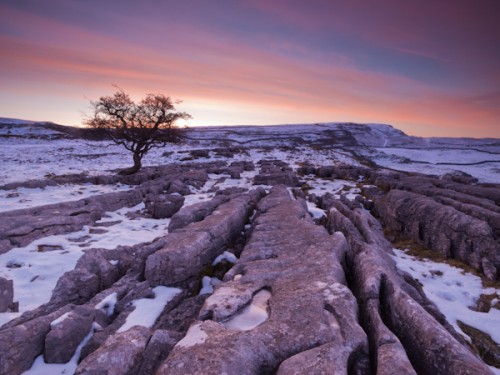
When you focus on an individual point within your landscape, you are in fact creating a plane of focus that lies parallel to the sensor. Everything in front of, and behind, that plane is technically not in focus, however there is a region within which objects will appear acceptably sharp – that is the depth of field. For instance, in the scene below the camera has been focussed on a rock. Therefore, the plane of focus lies parallel to the sensor across that rock and the limits of acceptable sharpness, that form the bounds of the depth of field, lie in front of, and behind, that plane.
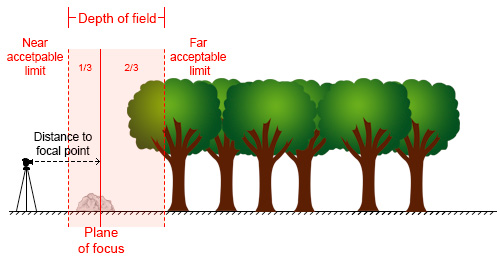
In the diagram above, the depth of field is not sufficient to capture all of the trees within the range of acceptable sharpness, i.e. they will appear out of focus. However, the depth of field can be easily manipulated to extend as far as you wish as it is controlled by a number of factors, namely: focal length, aperture and distance to the focal point. (I’m not going to include sensor size here as, after the purchase of your camera, it is not subject to user control; however it does not hurt to appreciate that the depth of field is inversely proportional to sensor size meaning that different cameras have different capabilities with respect to achievable depth of field). The relationship that these factors have with depth of field is given below:
Focal length: Up first is focal length as, typically, your focal length will be determined by your composition. Changing your focal length will alter your field of view and therefore your composition, meaning that you don’t often adjust your focal length to alter your depth of field but generally manipulate the other factors at your chosen focal length. A short focal length, i.e. wide-angle, will give you a greater depth of field than a long focal length, i.e. telephoto.
Aperture: Probably the most obvious factor in depth of field control is aperture. A narrower aperture, i.e. larger f/ number, gives you a greater depth of field and vice-versa. It is important to select the smallest, diffraction-limited aperture so to obtain the maximum depth of field without suffering from image degradation.
Distance to focal point: In combination with a given focal length and aperture, deciding where to place that plane of focus will impact the resulting depth of field. The depth of field increases as the distance to the focal point from the camera increases. Therefore, once a focal length has been chosen, it is generally the combination of the selected aperture and distance to the focal point that controls the depth of field.
Hyperfocal Distance
One way to ensure that the entire frame is in focus (well, ‘acceptably sharp’) is to ensure that the depth of field extends from the foreground to infinity. To do this, you need to focus at the ‘hyperfocal distance’: for a given focal length and aperture, there will be a distance where setting your point of focus will result in the entire scene being within the depth of field.
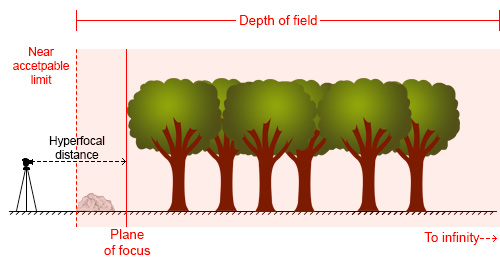
So theoretically, by selecting the correct aperture and moving the point of focus to the hyperfocal distance (assuming the composition and therefore focal length remain unchanged) it would be possible to render the entire scene in focus. A point worth noting is that when focussing at the hyperfocal distance, the near acceptable limit is always half of the hyperfocal distance.
The calculation to determine the hyperfocal distance isn’t trivial, so there are numerous sites or apps to help you when out in the field. However by frequent application, it isn’t long until you gain an appreciation of where to set your point of focus, for a given aperture at your commonly used focal lengths.
Aperture Selection
For any focal plane, the depth of field extends 1/3rd in front and 2/3rd behind the point of focus. Therefore, an easy, but potentially flawed, application of hyperfocal focussing is to select a very small aperture, e.g. f/22 or f/18, and to focus 1/3rd of the way into the scene from the bottom of the frame. It’s not a bad assumption, as often you will achieve the desired depth of field, however in choosing such a small aperture, you may well be losing any benefits of infinite focus due to decreased image sharpness as a result of diffraction.
For example, the image below shows a comparison of the same scene, shot at f/8 (left) and f/16 (right).
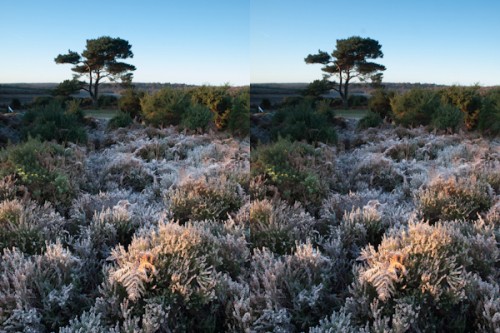
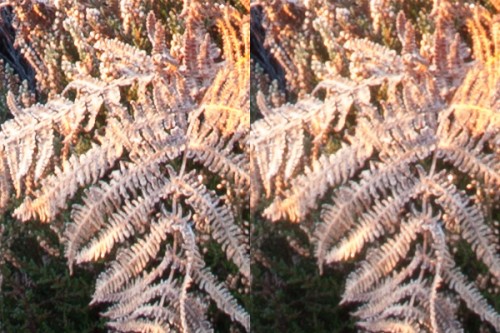
Diffraction becomes an issue all lenses as the aperture gets smaller, especially at the edges of the image, and will be more pronounced on inexpensive lenses. Typically, the sweet spot, in terms of lens performance, will be somewhere between f/8 and f/11. Therefore, use of the smallest ‘diffraction limited’ aperture that can still achieve the required depth of field becomes important.
So, hopefully, you will see that it is worth being aware of the hyperfocal distance for your commonly used focal lengths, especially for the apertures that result in optimum lens performance. With the tools available to us today, it isn’t difficult to work it out, even when out in the field, so why not give it a go the next time you are out photographing landscapes.



.gif)





